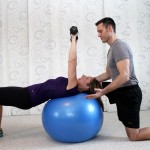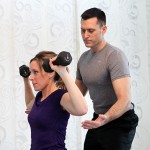Aerobic exercise, also called cardiorespiratory or cardiovascular fitness, is a good measure of the heart’s ability to pump oxygenated blood throughout the muscles. Oxygenated blood carries the nutrients the body needs to function effectively. A healthy heart can pump great volumes of oxygenated blood with each beat and will have a high level of cardiovascular fitness.
 Heart disease is directly associated with the cardiorespiratory and cardiovascular systems. One of the primary signs of heart and lung diseases include becoming winded with mild exertion. Individuals with heart or lung disease often become fatigued when performing day to day tasks that most of us take for granted. Aerobic exercise can help increase the body’s utilization of oxygenated blood pumping throughout the body, thus making our bodies stronger and more efficient performing everyday activities.
Heart disease is directly associated with the cardiorespiratory and cardiovascular systems. One of the primary signs of heart and lung diseases include becoming winded with mild exertion. Individuals with heart or lung disease often become fatigued when performing day to day tasks that most of us take for granted. Aerobic exercise can help increase the body’s utilization of oxygenated blood pumping throughout the body, thus making our bodies stronger and more efficient performing everyday activities.
I’m often asked what are the most important tips I can give for aerobic conditioning. I find myself continuously telling clients and friends three very important factors that will help to improve one’s cardiovascular health. These factors include: know your target heart rate zone, know your intensity level, and be consistent.
1. Know your target heart rate zone.
Your target heart rate zone is the number of beats per minute (bpm) at which your heart should be beating during aerobic exercise in order to promote optimal fitness levels, improving cardiovascular conditioning, and reducing body fat percentages. For most healthy individuals, this range is 60-85% of the maximal heart rate.
Measuring your heart rate while exercising can be done through two methods. Wearing a heart rate monitor is the easiest and most accurate method of checking your heart rate. A heart rate monitor can be purchased at any sporting goods supplier and ranges from $40 to $200. The least expensive are very accurate and will only display your heart rate. The moderately and highly priced monitors offer a stop watch, warning sounds if your heart rate is too high or too low, standard clock, and many other features.
The second method for monitoring your heart rate is by checking your pulse on your radial artery. The radial pulse can be found on the under side of your wrist using your index and middle fingers held together. Once located, count the number of beats for 15 seconds and multiply that number by 4. This will give you your beats per minute. To be more accurate, count the number of beats in 60 seconds. Both methods are acceptable for determining your heart rate.
2. Know your intensity level.
Once you have determined your beats per minute (within 5 minutes of aerobic exercise), you must ask yourself a few questions:
- At this intensity, am I in my target heart rate zone? If not, make adjustments accordingly:
- Above zone, decrease speed or rpms (or incline)
- Below zone, increase speed or rpms (or incline)
- How do I feel?
- Can I maintain this pace for at least 30 minutes?
- Can I push myself to the upper limits of my target heart rate zone?
- If so, how long will I hold that upper limit?
Be aware of how your body feels and how you are breathing. If you cannot hold a conversation with someone without catching your breath, you may be going at too fast of a pace. This is what we call the “talk test”.
Intensity levels can vary from person to person and by goals wanting to be reached. Please click here to view the 5 types of training zones which represent low to high intensity levels for cardio conditioning. These training zones will give you an idea of where you should be training for your individual goals.
3. Be consistent.
Consistency is the key when trying to lose weight and body fat. You must stay on your training program and maintain healthy eating habits until you reach your goal weight. Cardiovascular exercise should be done at least 3 days per week for minimal positive aerobic enhancement and reduction of body fat stores. For maximum results, intermediate and advanced trainees should be doing 5-6 days of cardiovascular conditioning per week, for a minimum of 20 minutes and not more than 60 minutes. Exercise modes include any activity (walking, jogging, inline skating, swimming, biking, etc.) that will get your heart rate up into your target heart rate zone.
Know your zone, know your intensity, and be consistent. I believe these 3 tips are most important in improving your aerobic capacity and will help you to lose unwanted weight. Keeping your heart strong is most important in building and maintaining a healthy body.





